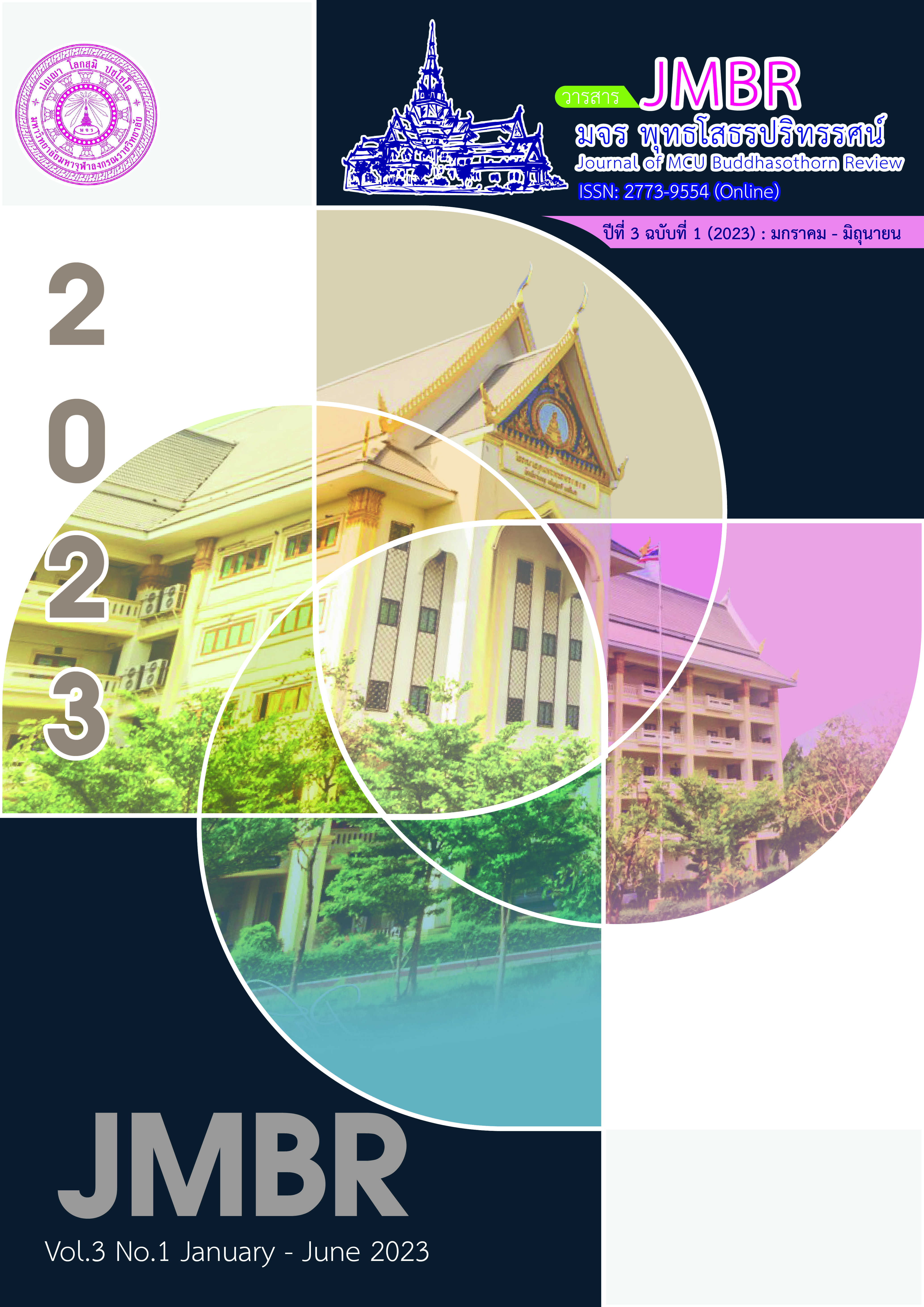Teaching and Learning Innovation is
Main Article Content
Abstract
In the situation of the epidemic of coronavirus disease 2019 (COVID-19) affecting almost every sector, this result was disruption widely as a local disease. The education industry has been greatly affected. The mostly infected people have the mild symptom to moderate symptoms, and then recover from the disease without curing in the hospital. Then, trying to find some ways to manage teaching in the next normal era is a challenge for all teachers. Therefore, the innovation of teaching the social studies should be the type of the Blended Learning in the next normal era that teachers should apply the type of an innovation of teaching, because it has a variety of alternative formats for students. Exactly, it is suitable for the learners in every type of learning. The teacher usually acts as the teaching director to encourage them and expand the scope of learning contents. Moreover, the students can choose their interesting topics and learn together with the teacher. To organize learning with the funny learning activities and create more entertainment and happiness through the learning media, technology, and teaching methods in various forms were the best choice of learning activities. These will cause the learners remembering and understanding the various content better, increasing their enthusiasm and they have been interested in learning. This will go or grow up with the development of a new meaningful lifestyle in the Next Normal Era.
Article Details

This work is licensed under a Creative Commons Attribution-NonCommercial-NoDerivatives 4.0 International License.
ต้นฉบับที่ได้รับการตีพิมพ์ในวารสาร มจร พุทธโสธรปริทรรศน์ วิทยาลัยสงฆ์พุทธโสธร มหาวิทยาลัยมหาจุฬาลงกรณราชวิทยาลัย ถือเป็นกรรมสิทธิ์ของวิทยาลัยสงฆ์พุทธโสธร มหาวิทยาลัยมหาจุฬาลงกรณราชวิทยาลัย ห้ามนำข้อความทั้งหมดหรือบางส่วนไปพิมพ์ซ้ำ เว้นเสีย แต่ว่าจะได้รับอนุญาตจากวิทยาลัยฯ เป็นลายลักษณ์อักษร และเพื่อให้เป็นไปตามกฎหมายลิขสิทธิ์ ผู้เขียนทุกท่านต้องลงลายมือชื่อในแบบฟอร์มใบมอบลิขสิทธิ์ บทความให้แก่วารสาร พร้อมกับบทความต้นฉบับที่ได้แก้ไขครั้งสุดท้าย นอกจากนี้ ผู้เขียนทุกท่านต้องยืนยันว่าบทความต้นฉบับที่ส่งมาตีพิมพ์นั้น ได้ส่งมาตีพิมพ์เฉพาะในวารสาร มจร พุทธโสธรปริทรรศน์ เพียงแห่งเดียวเท่านั้น
References
กระทรวงศึกษาธิการ. (2565). หลักเกณฑ์การเปิดโรงเรียนหรือสถาบันการศึกษา ตามข้อกำหนดออกตามความในมาตรา 9 แห่งพระราชกำหนดการบริหารราชการในสถานการณ์ฉุกเฉิน พ.ศ. 2548 (ฉบับที่ 37) ประกาศฉบับลงวันที่ 10 พฤษภาคม 2565. กรุงเทพฯ: ผู้แต่ง.
กุลธิดา ทุ่งคาใน. (2564). การเรียนรู้แบบผสมผสาน Blended Learning ในวิถี New Normal Blended Learning in a New Normal. ครุศาสตร์สาร. 15 (1), 29-43.
จตุรงค์ พยอมแย้ม. (26 มกราคม 2565). การศึกษาไทยในยุค next normal. สืบค้นเมื่อ 19 สิงหาคม 2565, จาก https://il.mahidol.ac.th/th/newsletter64-page-9/.
จินตวีร์ คล้ายสังข์. (2563). เอกสารสรุปการบรรยายการอบรมเชิงวิชาการ การอบรมเชิงวิชาการ เรื่องการเรียนรู้แบบผสมผสาน (Blended Learning). มหาวิทยาลัยหัวเฉียวเฉลิมพระเกียรติ.
จุฬาลงกรณ์มหาวิทยาลัย. (2020). ข่าวสารจุฬาฯ คิดใหม่ ทำใหม่ กับการเรียนการสอนออนไลน์ในช่วง COVID-19. สืบค้นเมื่อวันที่ 8 สิงหาคม 2565, จาก https://www.chula.ac.th/news/29739/.
ฉลองรัฐ เฌอมาลย์ชลมารค. NEXT NORMAL กับวิถีใหม่แห่งการสื่อสาร, สารรังสิต Online. สืบค้นเมื่อ 19 สิงหาคม 2565, จาก https://www2.rsu.ac.th/sarnrangsit-onlinedetail/CommArts-Article15.
เทื้อน ทองแก้ว. (2563). การออกแบบการศึกษาในชีวิตวิถีใหม่: ผลกระทบจากการแพร่ระบาด COVID-19. คุรุสภาวิทยาจารย์, 1(2), 10.
บัลลังก์ โรหิตเสถียร. ข่าว ศธ. 360 องศา. สืบค้นเมื่อวันที่ 8 กันยายน 2565, จาก https://www.moe.go.th.
มารุต พัฒผล และคณะ. (2564). แนวทางการจัดการเรียนรู้แบบผสมผสานเพื่อพัฒนาศักยภาพของผู้เรียนระดับการศึกษาขั้นพื้นฐานในสถานการณ์การแพร่ระบาดของโรคติดเชื้อไวรัสโคโรนา 2019 (COVID-19). กรุงเทพฯ: สำนักงานเลขาธิการสภาการศึกษา.
มูลนิธิคีนันแห่งเอเชีย. (2563). การแพร่ระบาดของโควิด-19 สร้างผลกระทบต่อการศึกษาไทย. สืบค้นเมื่อวันที่ 8 สิงหาคม 2565, จาก https://www.kenan-asia.org/th/covid-19-education-impact/.
เสกสันต์ พันธุ์บุญมี. (2565). Digital Transformation จาก New Normal สู่ Next Normal. สืบค้นเมื่อ 9 สิงหาคม 2565, จาก https://www.depa.or.th/th/article-view/digital- transformation-new-normal-next-normal.
อานุภาพ เลขะกุล. (2564). ความปกติถัดไปอุดมศึกษา: ความท้าทาย. วารสารการศึกษาและนวัตกรรมการเรียนรู้. 1(2), 111-125ใ
Curtin, R. (2021). Reimagining higher education: the post-covid classroom. Educause Review. Retrieved form https://er.educause.edu/articles/2021/4/reimagining-higher-educationthe-post-covid-classroom.
Hajsadr, Massoud. (2007). Blended Learning and Animations. Accessed April 22. Available from http://www.elesson.co.uk/blended.asp.
Huang, Ronghuai, and Yueliang Zhou. (2003). Designing Blended Learning Focused on Knowledge Category and Learning Activities. Accessed February 26. Available from http://citeseerx.ist.psu.edu/showciting;jsessionid=F5970713AF6759CFD8E746FF32D10D7E?cid=5174168.
Singh, H., & Reed, C. (2001). A Write Paper: Achieving Success with Blended Learning. https://www.docin.com/p-1815130868.html.
Tanamit, Kongkiat. (2551). Blended Learning. Accessed February 26. Available from http://202.44.43.230/det3/kkt/images/การเรียนแบบผสมผสาน.pdf.
World Economic Forum. (2020). Education in a Post-COVID World. Nine Ideas for Public Action.


